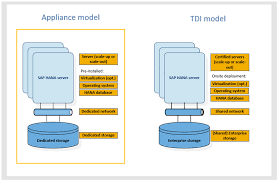
- What is SAP FICO on HANA? Answer: SAP FICO on HANA is an integrated module that combines the functionalities of SAP Finance (FI) and Controlling (CO) with the in-memory computing capabilities of SAP HANA. It enables faster data processing, real-time reporting, and advanced analytics for financial management and controlling processes.
- What are the main components of SAP FICO on HANA? Answer: The main components of SAP FICO on HANA are Financial Accounting (FI), Controlling (CO), General Ledger (GL), Accounts Payable (AP), Accounts Receivable (AR), Asset Accounting (AA), Cost Element Accounting, Profit Center Accounting, and Profitability Analysis (CO-PA).
- Explain the key benefits of using SAP FICO on HANA. Answer: The key benefits of SAP FICO on HANA include real-time data processing and reporting, improved performance and scalability, advanced analytics capabilities, simplified data models, enhanced data integration, reduced data footprint, and faster decision-making.
- What is the significance of SAP HANA in SAP FICO? Answer: SAP HANA provides in-memory computing capabilities to SAP FICO, enabling high-speed data processing and analysis. It eliminates the need for traditional disk-based databases, improves system performance, allows real-time reporting and analytics, and facilitates faster financial close processes.
- How does SAP FICO on HANA improve financial reporting? Answer: SAP FICO on HANA enables real-time financial reporting by processing large volumes of data in memory. It eliminates the need for batch processes and data replication, allowing users to access up-to-date financial information instantly and generate real-time reports with greater accuracy and speed.
- What is the Universal Journal in SAP FICO on HANA?
Answer: The Universal Journal is a single source of truth in SAP FICO on HANA. It combines financial and controlling data into a unified structure, eliminating the need for data replication and reconciliation. It provides a real-time view of financial transactions and enables flexible reporting and analysis. - How does SAP FICO on HANA support predictive analytics?
Answer: SAP FICO on HANA leverages the advanced analytics capabilities of SAP HANA to support predictive analytics. It enables users to analyze historical financial data, identify trends and patterns, perform forecasting, and make data-driven predictions for financial planning and decision-making. - What is the significance of SAP S/4HANA for SAP FICO? Answer: SAP S/4HANA is the next-generation business suite that integrates SAP FICO on HANA and other SAP modules. It provides a simplified data model, real-time analytics, advanced user experience, and streamlined business processes, enabling organizations to optimize their financial operations and drive digital transformation.
- How does SAP FICO on HANA enhance cash management processes? Answer: SAP FICO on HANA provides real-time visibility into cash positions, liquidity planning, and cash flow forecasting. It enables organizations to monitor and analyze cash flows, optimize working capital, streamline cash management processes, and make informed decisions to improve cash flow and liquidity management.
- Explain the integration between SAP FICO and other SAP modules. Answer: SAP FICO integrates with various other SAP modules such as Sales and Distribution (SD), Materials Management (MM), Production Planning (PP), and Human Capital Management (HCM). This integration ensures seamless flow of financial data across different functional areas, facilitating accurate financial reporting and analysis.
- How does SAP FICO on HANA handle financial close processes? Answer: SAP FICO on HANA accelerates financial close processes by providing real-time data processing and analysis. It enables faster period-end closing, real-time consolidation of financial data, automatic reconciliation, real-time intercompany eliminations, and immediate availability of financial statements and reports.
- What is the role of SAP HANA Live in SAP FICO on HANA? Answer: SAP HANA Live is a virtual data model provided by SAP that enables real-time operational reporting and analytics in SAP FICO on HANA. It offers pre-built analytical content and reporting templates, allowing users to access and analyze financial data in real time using SAP Fiori or other reporting tools.
- How does SAP FICO on HANA handle data migration from a non-HANA system? Answer: SAP provides tools and methodologies such as SAP Data Services and SAP Rapid Deployment Solutions (RDS) to facilitate data migration from a non-HANA system to SAP FICO on HANA. These tools help extract, transform, and load data into the SAP HANA database, ensuring a smooth transition.
- Explain the benefits of real-time profitability analysis (CO-PA) in SAP FICO on HANA. Answer: Real-time profitability analysis in SAP FICO on HANA provides immediate insights into product profitability, customer profitability, and profitability by sales channels. It allows organizations to analyze revenue, costs, and profitability in real time, identify profit drivers, and make informed business decisions.
- How does SAP FICO on HANA support financial planning and analysis (FP&A)? Answer: SAP FICO on HANA supports FP&A by providing real-time financial data, integrated financial planning capabilities, and advanced analytics. It enables organizations to create financial plans, perform budgeting and forecasting, analyze variances, simulate scenarios, and optimize financial performance.
- What is the role of SAP Fiori in SAP FICO on HANA? Answer: SAP Fiori is the user experience (UX) platform that provides a role-based, responsive, and intuitive interface for SAP applications, including SAP FICO on HANA. It offers personalized dashboards, interactive reports, and self-service capabilities, enhancing user productivity and simplifying financial processes.
- How does SAP FICO on HANA improve financial compliance? Answer: SAP FICO on HANA improves financial compliance by providing real-time visibility into financial data, enabling accurate and timely reporting, automating compliance checks, and facilitating audit trails. It helps organizations meet regulatory requirements and internal control standards more efficiently.
- What is the role of Central Finance in SAP FICO on HANA? Answer: Central Finance is a feature of SAP S/4HANA that allows organizations to centralize financial data from multiple systems into a single SAP S/4HANA instance. It enables real-time financial reporting, harmonizes financial processes across the organization, and supports mergers, acquisitions, and divestitures.
- How does SAP FICO on HANA handle cost accounting and profitability analysis? Answer: SAP FICO on HANA provides comprehensive cost accounting and profitability analysis capabilities. It enables organizations to track costs by cost centers, cost elements, and activities, perform cost allocations and overhead calculations, and analyze profitability by products, customers, and business segments.
- What is the role of SAP Cash Management in SAP FICO on HANA? Answer: SAP Cash Management is a module within SAP FICO on HANA that enables organizations to optimize cash flow, liquidity planning, and treasury management. It provides real-time visibility into cash positions, cash forecasting, cash pooling, and bank account reconciliation, helping organizations effectively manage their cash resources.
- How does SAP FICO on HANA support compliance with International Financial Reporting Standards (IFRS)? Answer: SAP FICO on HANA offers functionalities specifically designed to support compliance with IFRS. It provides pre-configured IFRS accounting principles, automated IFRS reporting templates, and features such as parallel accounting, lease accounting (IFRS 16), and revenue recognition (IFRS 15) to ensure accurate and compliant financial reporting according to IFRS standards.
- What is the role of SAP Business Planning and Consolidation (BPC) in SAP FICO on HANA? Answer: SAP BPC is a financial planning and consolidation tool that integrates with SAP FICO on HANA. It allows organizations to perform budgeting, forecasting, financial consolidation, and reporting processes. It leverages the power of SAP HANA for real-time data processing and analysis.
- How does SAP FICO on HANA handle intercompany reconciliation and elimination processes? Answer: SAP FICO on HANA automates intercompany reconciliation and elimination processes in real time. It compares transactions between intercompany partners, identifies discrepancies, automatically reconciles intercompany balances, and eliminates intercompany profit or loss, ensuring accurate financial reporting and consolidation.
- What are the key steps involved in implementing SAP FICO on HANA? Answer: The key steps in implementing SAP FICO on HANA include project scoping, system landscape design, data migration, configuration, testing, user training, and system go-live. It is important to involve stakeholders, define requirements, plan the implementation timeline, and ensure a smooth transition from legacy systems.
- How does SAP FICO on HANA integrate with external systems and third-party applications? Answer: SAP FICO on HANA supports various integration options, including application programming interfaces (APIs), web services, and data integration tools. It can integrate with external systems such as banks, payment gateways, tax authorities, and reporting systems to exchange financial data and streamline processes.
- Explain the concept of real-time profit center accounting in SAP FICO on HANA. Answer: Real-time profit center accounting in SAP FICO on HANA provides immediate insights into profit and loss by profit centers. It allows organizations to analyze revenues, costs, and profitability for each profit center in real time, helping management make informed decisions and optimize business performance.
- How does SAP FICO on HANA handle financial risk management? Answer: SAP FICO on HANA supports financial risk management by providing real-time data analysis and monitoring capabilities. It enables organizations to identify and assess financial risks, such as credit risk, market risk, and liquidity risk, and take proactive measures to mitigate risks and ensure financial stability.
- What is the role of SAP Real-Time Consolidation (RTC) in SAP FICO on HANA? Answer: SAP RTC is a consolidation solution that integrates with SAP FICO on HANA. It enables real-time financial consolidation and group reporting processes, automates intercompany eliminations, performs currency translations, and ensures compliance with legal and regulatory requirements for consolidated financial statements.
- How does SAP FICO on HANA support cost center accounting? Answer: SAP FICO on HANA supports cost center accounting by allowing organizations to track and analyze costs incurred by different cost centers. It enables cost allocation, cost planning, variance analysis, and reporting of cost center expenses, helping organizations manage and control costs effectively.
- Explain the concept of parallel accounting in SAP FICO on HANA. Answer: Parallel accounting in SAP FICO on HANA allows organizations to maintain multiple sets of books to comply with different accounting principles or legal requirements. It enables parallel valuation, parallel reporting, and parallel financial statements for different accounting standards, such as local GAAP and IFRS.
- How does SAP FICO on HANA support asset accounting? Answer: SAP FICO on HANA supports asset accounting by providing functionalities for asset master data management, depreciation calculation, asset acquisition and retirement, asset transfers, and asset reporting. It allows organizations to effectively manage and track their fixed assets and comply with asset accounting standards.
- What is the role of SAPGroup Reporting in SAP FICO on HANA? Answer: SAP Group Reporting is a solution that integrates with SAP FICO on HANA to enable group consolidation and financial reporting processes. It provides functionalities for data collection, consolidation, intercompany eliminations, currency translation, and preparation of consolidated financial statements for group entities.
- How does SAP FICO on HANA handle tax accounting and compliance? Answer: SAP FICO on HANA supports tax accounting and compliance through features such as tax codes, tax calculation rules, tax reporting templates, and integration with tax authorities. It automates tax calculations, ensures accurate tax reporting, and helps organizations comply with tax regulations and requirements.
- What is the role of SAP Cash Application in SAP FICO on HANA? Answer: SAP Cash Application is a functionality that automates the process of applying incoming payments to open customer invoices. It uses machine learning algorithms to match payments with invoices, reducing manual effort and improving efficiency in cash management and accounts receivable processes.
- How does SAP FICO on HANA handle foreign currency valuation? Answer: SAP FICO on HANA handles foreign currency valuation by applying exchange rate changes to financial transactions and balances. It supports periodic valuation of foreign currency items, revaluation of open items, and automatic generation of valuation postings to ensure accurate reporting of foreign currency positions and gains or losses.
- What is the role of SAP Credit Management in SAP FICO on HANA? Answer: SAP Credit Management is a functionality that enables organizations to manage credit limits, credit exposure, and credit risk. It integrates with SAP FICO on HANA to automate credit checks, credit evaluations, credit scoring, and credit limit monitoring, helping organizations make informed credit decisions and minimize credit risk.
- How does SAP FICO on HANA handle financial data analytics? Answer: SAP FICO on HANA leverages the advanced analytics capabilities of SAP HANA to perform financial data analytics. It allows organizations to analyze financial data in real time, generate interactive reports and dashboards, perform ad hoc queries, and gain valuable insights into financial performance and trends.
- What is the role of SAP Profitability and Performance Management (PaPM) in SAP FICO on HANA? Answer: SAP PaPM is a solution that integrates with SAP FICO on HANA to support advanced profitability analysis and performance management. It provides functionalities for cost allocations, driver-based planning, profitability simulations, and advanced analytics to optimize profitability and improve business performance.
- How does SAP FICO on HANA handle cost center planning and budgeting? Answer: SAP FICO on HANA supports cost center planning and budgeting by providing functionalities for creating cost center budgets, allocating costs, tracking actual expenses, and comparing them with budgeted amounts. It enables organizations to monitor cost center performance, analyze variances, and make informed budgeting decisions.
- What is the role of SAP Revenue Accounting and Reporting (RAR) in SAP FICO on HANA? Answer: SAP RAR is a solution that integrates with SAP FICO on HANA to handle revenue recognition processes according to accounting standards such as IFRS 15 and ASC 606. It automates revenue recognition calculations, generates revenue reports, and ensures compliance with revenue recognition requirements.
- How does SAP FICO on HANA handle financial risk analysis and mitigation? Answer: SAP FICO on HANA supports financial risk analysis and mitigation by providing real-time data analysis, risk modeling, and risk monitoring capabilities. It enables organizations to identify and assess financial risks, such as credit risk, liquidity risk, and market risk, and take proactive measures to mitigate risks and protect financial stability.
- What is the role of SAP Lease Administration by Nakisa in SAP FICO on HANA? Answer: SAP Lease Administration by Nakisa is a solution that integrateswith SAP FICO on HANA to handle lease accounting processes according to accounting standards such as IFRS 16 and ASC 842. It automates lease data management, lease calculations, lease classification, and generation of lease accounting postings.
- How does SAP FICO on HANA support financial forecasting and predictive analytics? Answer: SAP FICO on HANA supports financial forecasting and predictive analytics by leveraging the advanced analytics capabilities of SAP HANA. It allows organizations to analyze historical financial data, identify trends and patterns, perform predictive modeling, and make data-driven forecasts for financial planning and decision-making.
- What is the role of SAP Bank Communication Management (BCM) in SAP FICO on HANA? Answer: SAP BCM is a functionality that integrates with SAP FICO on HANA to streamline communication and electronic banking processes. It enables organizations to manage bank accounts, process electronic payments and collections, and automate bank statement reconciliation, improving efficiency and accuracy in cash management and accounts receivable processes.
- How does SAP FICO on HANA handle budgeting and financial planning processes? Answer: SAP FICO on HANA supports budgeting and financial planning processes by providing functionalities for creating budgets, defining planning scenarios, allocating budget amounts, and comparing actuals with budgets. It enables organizations to perform detailed financial planning, monitor budget performance, and make informed financial decisions.
- What is the role of SAP Disclosure Management in SAP FICO on HANA? Answer: SAP Disclosure Management is a solution that integrates with SAP FICO on HANA to streamline financial reporting and disclosure processes. It allows organizations to create and manage financial statements, automate the generation of regulatory reports, and ensure compliance with reporting standards and requirements.
- How does SAP FICO on HANA handle cost object controlling? Answer: SAP FICO on HANA handles cost object controlling by providing functionalities for tracking costs and revenues associated with specific cost objects, such as products, projects, or orders. It enables organizations to analyze costs, calculate profitability, and make informed decisions based on cost object performance.
- What is the role of SAP Profitability Analysis (CO-PA) Accelerator in SAP FICO on HANA? Answer: The CO-PA Accelerator is a component of SAP FICO on HANA that enhances the performance of profitability analysis (CO-PA) processes. It leverages the in-memory computing capabilities of SAP HANA to speed up data processing and analysis, allowing organizations to perform real-time profitability analysis and reporting.
- How does SAP FICO on HANA handle treasury and cash management processes? Answer: SAP FICO on HANA handles treasury and cash management processes by providing functionalities for cash position management, liquidity planning, cash flow forecasting, bank account management, and risk management. It enables organizations to optimize their cash resources, ensure liquidity, and effectively manage financial risks.
- What is the role of SAP FICO on HANA in financial governance and compliance? Answer: SAP FICO on HANA supports financial governance and compliance by providing functionalities for internal controls, financial audits, risk management, and compliance reporting. It helps organizations enforce financial policies, ensure data integrity, and meet regulatory requirements to maintain financial transparency and integrity.




